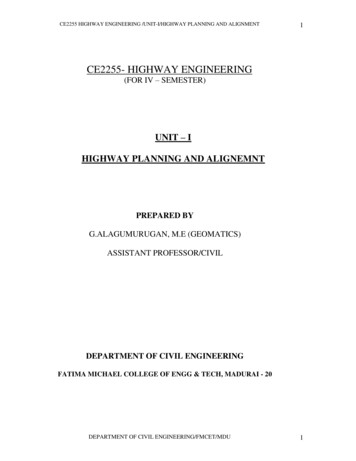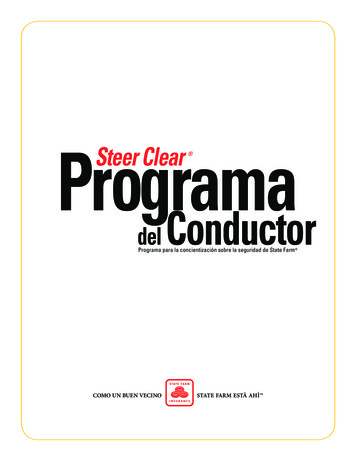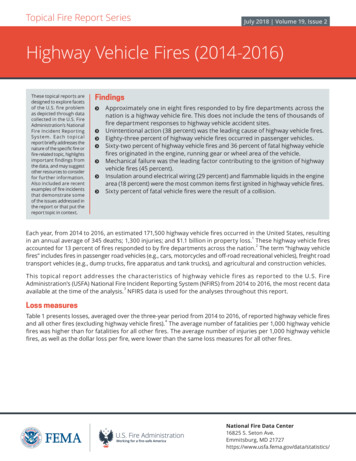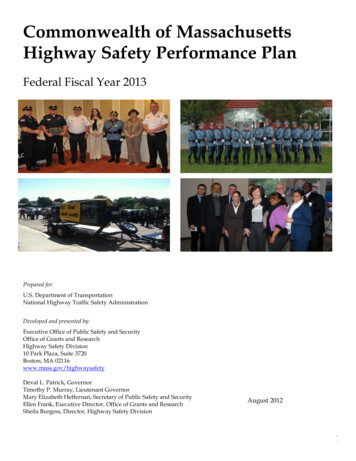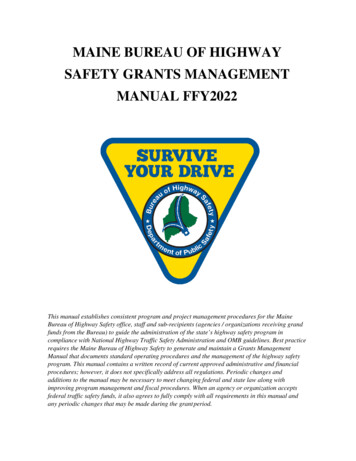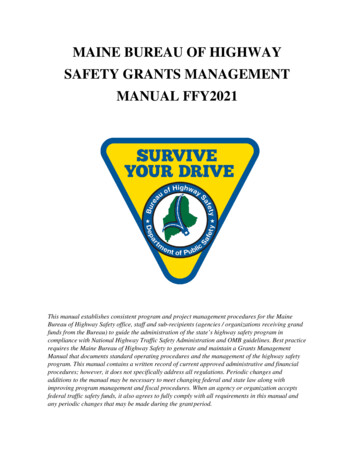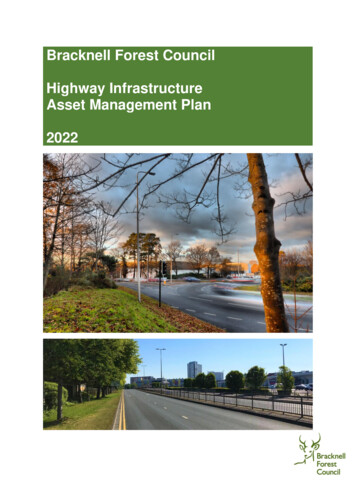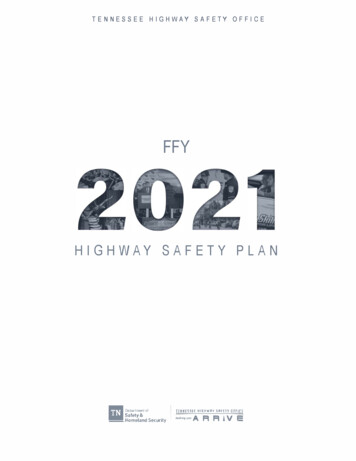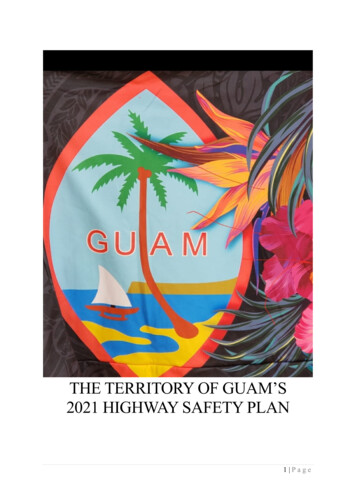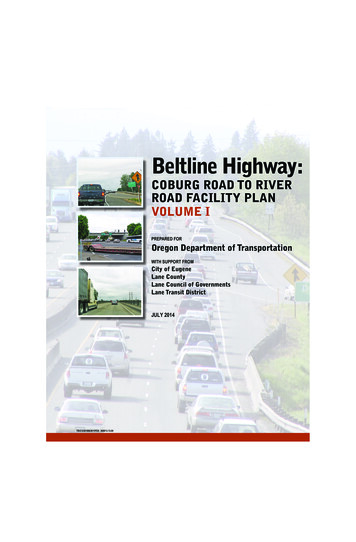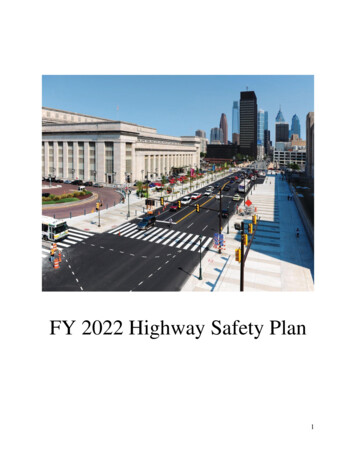
Transcription
FY 2022 Highway Safety Plan1
ContentsHighway Safety Plan. 6Highway Safety Planning Process . 7Data Sources and Processes . 7Processes Participants . 11Description of Highway Safety Problems . 14Methods for Project Selection . 19List of Information and Data Sources . 21Description of Outcomes . 22Performance report. 23Performance Measure: C-1) Number of traffic fatalities (FARS) . 23Performance Measure: C-2) Number of serious injuries in traffic crashes (State crash datafiles) . 23Performance Measure: C-3) Fatalities/VMT (FARS, FHWA) . 23Performance Measure: C-4) Number of unrestrained passenger vehicle occupant fatalities, allseat positions (FARS). 23Performance Measure: C-5) Number of fatalities in crashes involving a driver or motorcycleoperator with a BAC of .08 and above (State Data). 24Performance Measure: C-6) Number of speeding-related fatalities (FARS) . 24Performance Measure: C-7) Number of motorcyclist fatalities (FARS) . 24Performance Measure: C-8) Number of unhelmeted motorcyclist fatalities (FARS) . 24Performance Measure: C-9) Number of drivers age 20 or younger involved in fatal crashes(FARS) . 25Performance Measure: C-10) Number of pedestrian fatalities (FARS) . 25Performance Measure: C-11) Number of bicyclist fatalities (FARS) . 25Performance Measure: B-1) Observed seat belt use for passenger vehicles, front seat outboardoccupants (survey). 25Performance Measure: Drug Impaired Driver Crashes . 26Performance Measure: Completeness . 26Performance Measure: Accuracy . 26Performance Measure: Timeliness . 26Performance Measure: Complete Projects to Enhance Driver Education in Pennsylvania . 26Performance Measure: Distracted Driving Fatalities . 272
Performance Plan . 28Performance Measure Charts and Targets . 29Performance Measure: C-1) Number of traffic fatalities (FARS) . 32Performance Measure: C-2) Number of serious injuries in traffic crashes (State crash datafiles) . 32Performance Measure: C-3) Fatalities/VMT (FARS, FHWA) . 33Performance Measure: C-4) Number of unrestrained passenger vehicle occupant fatalities, allseat positions (FARS). 33Performance Measure: C-5) Number of fatalities in crashes involving a driver or motorcycleoperator with a BAC of .08 and above (FARS) . 34Performance Measure: C-6) Number of speeding-related fatalities (FARS) . 34Performance Measure: C-7) Number of motorcyclist fatalities (FARS) . 34Performance Measure: C-8) Number of unhelmeted motorcyclist fatalities (FARS) . 35Performance Measure: C-9) Number of drivers age 20 or younger involved in fatal crashes(FARS) . 35Performance Measure: C-10) Number of pedestrian fatalities (FARS) . 35Performance Measure: C-11) Number of bicyclist fatalities (FARS) . 36Performance Measure: B-1) Observed seat belt use for passenger vehicles, front seat outboardoccupants (survey). 36Performance Measure: Drug Impaired Driver Crashes . 36Performance Measure: Completeness . 37Performance Measure: Accuracy . 37Performance Measure: Timeliness . 38Performance Measure: Complete Projects to Enhance Driver Education in Pennsylvania . 38Performance Measure: Distracted Driving Fatalities . 38Certification:. 39Program areas. 40Program Area: Communications (Media) . 40Countermeasure Strategy: Communication Campaign (Media) . 43Program Area: Community Traffic Safety Program . 45Countermeasure Strategy: Educational and Outreach Programs (CTSP) . 47Planned Activity: Community Traffic Safety Projects . 48Countermeasure Strategy: PA Highway Safety Office Program Management . 48Planned Activity: Grant Program Training Needs . 493
Planned Activity: PA Highway Safety Office Program Management . 50Program Area: Driver Education and Behavior . 51Countermeasure Strategy: Diversion and Plea Agreement Restrictions; Traffic Violator School. 52Planned Activity: Implementation of a Driver Improvement School . 53Countermeasure Strategy: Educational and Outreach Programs . 54Planned Activity: Novice Driver Statewide Program Support. 55Program Area: Impaired Driving (Drug and Alcohol) . 56Countermeasure Strategy: DWI Courts. 59Planned Activity: DUI Courts . 60Countermeasure Strategy: High Visibility and Sustained DUI Enforcement . 61Planned Activity: PA State Police Traffic Safety Initiatives . 62Planned Activity: Municipal Police Traffic Services Enforcement Program . 63Countermeasure Strategy: Judicial Education. 65Planned Activity: Judicial Outreach Liaison . 65Countermeasure Strategy: Law Enforcement Training . 66Planned Activity: Institute for Law Enforcement Education . 67Planned Activity: Statewide DUI Program Coordination . 68Countermeasure Strategy: Prosecutor Training . 70Planned Activity: Traffic Safety Resource Prosecutor . 70Program Area: Motorcycle Safety. 72Countermeasure Strategy: Communication Campaign (MC) . 73Planned Activity: Motorcycle Safety Initiatives . 74Program Area: Non-motorized (Pedestrians and Bicyclist) . 75Countermeasure Strategy: Communication Campaign (Ped/Bike) . 77Planned Activity: Nonmotorized HVE Campaign Support . 78Countermeasure Strategy: High Visibility Nonmotorized Enforcement . 78Planned Activity: PA State Police - Nonmotorized Enforcement Program . 80Planned Activity: Municipal Police Traffic Services Enforcement Program . 81Program Area: Occupant Protection (Adult and Child Passenger Safety) . 82Countermeasure Strategy: Child Restraint System Inspection Station(s) . 85Planned Activity: PA State Police Traffic Safety Initiatives . 86Planned Activity: Statewide Child Passenger Safety Program Coordination . 874
Countermeasure Strategy: High Visibility and Sustained OP Enforcement . 92Planned Activity: PA State Police Traffic Safety Initiatives . 96Planned Activity: Municipal Police Traffic Services Enforcement Program . 97Program Area: Planning & Administration . 99Planned Activity: Planning & Administration - PA Highway Safety Office Management . 99Program Area: Police Traffic Services. 100Countermeasure Strategy: High Visibility and Sustained PTS Enforcement . 101Planned Activity: PA State Police Traffic Safety Initiatives . 102Planned Activity: Statewide LEL Program Coordination . 104Planned Activity: Municipal Police Traffic Services Enforcement Program . 104Program Area: Traffic Records . 106Countermeasure Strategy: Improves one or more performance measures of a core highwaysafety database. 107Planned Activity: M.A.C.H. Software Pilot . 108Planned Activity: Crash Case Backlog . 109Planned Activity: Implementation of Local Roads to PennDOT’s Databases. 110Planned Activity: CDART System Enhancements . 110Planned Activity: CRS System Enhancements . 111Countermeasure Strategy: Improves one or more performance measures of one or more corehighway safety databases . 111Planned Activity: Statewide Traffic Records Program Support . 112Planned Activity: Crash Architecture and Public/Private Data Interface . 114Planned Activity: Re-write of portions of the Vehicle Registration and Driver LicensingSystems. 115Evidence-based traffic safety enforcement program (TSEP) . 116High-visibility enforcement (HVE) strategies . 119405(b) Occupant protection grant . 121405(c) State traffic safety information system improvements grant . 135405(d) Impaired driving countermeasures grant . 141405(f) Motorcyclist safety grant . 142Certifications, Assurances, and Highway Safety Plan PDFs . 1455
Highway Safety PlanNATIONAL PRIORITY SAFETY PROGRAM INCENTIVE GRANTS - The Stateapplied for the following incentive grants:S. 405(b) Occupant Protection: YesS. 405(e) Distracted Driving: NoS. 405(c) State Traffic Safety Information System Improvements: YesS. 405(f) Motorcyclist Safety Grants: YesS. 405(d) Impaired Driving Countermeasures: YesS. 405(g) State Graduated Driver Licensing Incentive: NoS. 405(d) Alcohol-Ignition Interlock Law: NoS. 405(h) Nonmotorized Safety: YesS. 405(d) 24-7 Sobriety Programs: NoS. 1906 Racial Profiling Data Collection: No6
Highway Safety Planning ProcessData Sources and ProcessesTimeline and Planning ProcessThe Highway Safety Traffic and Operations Division (HSTOD) conducts transportation safetyplanning year-round. Emerging trends and safety needs are identified through data monitoringand outreach to key safety stakeholders. Below, the Overview of HSP Planning Process andAnnual Safety Planning Calendar depict the annual planning cycle.To identify the state's overall highway safety problems, HSTOD analyzes a variety of data usingsources including but not limited to Pennsylvania's Crash Reporting System, arrest and citationdata reported through the state's e-grants system, the PA Department of Health's database, andothers.Overview of HSP Planning ProcessAnnual Safety Planning CalendarMonthActivitiesOctoberSolicit final reports and claims for grants ending September 30th.Program staff begins work on FFY 2021 Annual Report. The firstmeeting of the annual Spring Traffic Safety Grantee Workshop planningcommittee is held. Conduct activities for CIOT Teen Mobilization incoordination with National Teen Driver Safety Week and beginAggressive Driving Enforcement Wave 1. Conduct the virtual FallCommunications Workshop for PennDOT safety grantees and SafetyPress Officers.NovemberConduct first meeting of Safety Advisory Committee (SAC) to beginplanning FFY 2023 Highway Safety Plan. Final reimbursement claimsfor FFY 2021 are processed.DecemberFinalize FFY 2021 Annual Report. Conduct second meeting of the SAC.Coordinate participation in the Holiday Season Impaired DrivingCampaign.7
JanuaryConduct final SAC meeting to establish FFY 2023 program areacountermeasures and budgets. Program staff begins FFY 2022 projectmonitoring visits.February and March Submit FFY 2023 program budget to PennDOT Program ManagementCommittee for executive approval. Coordinate Super Bowl and St.Patrick's Day Impaired Driving mobilization. Begin Aggressive DrivingEnforcement Wave 2. Conduct Spring Traffic Safety Grantee Workshop.Develop plan for participation in the National CIOT mobilization.April to JuneSolicit applicants for new FFY 2023 local grant opportunities and beginpreparation of FFY 2023 Highway Safety Plan (HSP) and 405certifications. Coordinate new Highway Safety Grant Agreements forFFY 2023 state projects approved by the SAC. Conduct activities forNational Distracted Driving Awareness M and National Work ZoneAwareness Week.May and JuneFinalize FFY 2023 HSP and 405 certifications after soliciting internaland NHTSA Regional Office comments. Participate in the NationalCIOT mobilization and coordinate activities for National MotorcycleSafety Awareness, National Youth Traffic Safety, and National BicycleSafety Months. Develop plan for participation in the 4th of July andNational Crackdown Impaired Driving Campaigns.JulySubmit final HSP and 405 certifications to NHTSA. Begin AggressiveDriving Enforcement Wave 3. Coordinate activities for Child PassengerSafety Week. Begin planning for the virtual Fall CommunicationsWorkshop.August andSeptemberComplete selection and subsequent negotiations of FFY 2023 localgrants. Complete processing of FFY 2023 local and state agreements.Participate in the National Impaired Driving Crackdown and ChildPassenger Safety Week. Send out close-out reminders to FFY 2022grantees. Review and approve changes to multi-year agreements (asapplicable).COVID-19 Impacts to Planning ProcessTo mitigate risks associated with in-person meetings during the COVID-19 Pandemic,Pennsylvania’s Highway Safety Office and partners acted quickly. We transitioned in-personevents to virtual platforms in order to continue to provide essential information and updates toour network for training related to law enforcement, community outreach, and education. ForFFY2022, the Fall Outreach Coordination Workshop will again be held virtually, as will thosetrainings offered through the PA DUI Association and the Institute for Law EnforcementEducation (ILEE) that are able to be converted to a virtual environment. The Annual PA TrafficSafety Conference is tentatively being planned as an in-person event during April 2022. Safety8
partners and grantees will continue to follow the guidance of their agencies as to attending anyin-person events. PennDOT will continue to promote the wellbeing of our safety partners andstaff, encouraging compliance with state and local health authorities’ guidelines.Strategic Partners and StakeholdersThe Safety Advisory Committee (SAC) members provide input on safety program areas andeffective countermeasures to help achieve HSTOD’s vision and mission. The SAC provides abroad perspective in the alignment of behavioral highway safety programs across all criticalsafety partners in Pennsylvania. They also approve funding levels for broader state and localsafety programs which satisfy fund qualifying criteria and eligibility, legislative requirements,and contract coverage. Behavioral programs involve police traffic enforcement in combinationwith public education and information activities. Infrastructure safety programs deal withphysical infrastructure improvements and are not addressed by the SAC. Infrastructure safetyprograms are identified in the FHWA Highway Safety Improvement Program and also inaccordance with PennDOT Publication 638 (District Safety Manual).The SAC consists of representatives from PennDOT, Pennsylvania Department of Health,Pennsylvania State Police, National Highway Traffic Safety Administration, Federal HighwayAdministration, and representatives from local government and police departments. The ProgramManagement Committee (PMC) is a PennDOT executive-level committee and approves theState’s overall Highway Safety Program based upon the targets and priorities established in theSHSP. The PMC has final approval on all budget changes.To implement the highway safety plan, the SAC divides state and Federal money among statelevel and local grant funds. Beginning in FFY 2019, the SAC approved multi-year programbudgets to enable grant agreement periods covering both FFY 2019 and 2020 and has done soagain for FFY 2021-2022. These multi-year agreements will reduce agreement processing time,administrative costs, and support long-term planning by subgrantees. The SAC will continue toreview and approve each federal fiscal year period budget to allow opportunities for adjustmentsbased on new data and other information. Subgrantees working under multi-year agreements arerequired to annually assess work plans and budgets to adapt plans as necessary.Countermeasure and Strategy Selection ProcessThe statewide safety partners work to achieve Pennsylvania’s safety targets through the use ofproven countermeasure activities that address crashes and fatalities in the safety focus areas.Each program area depicts state crash data to provide justification for including the program areaand guides the selection and implementation of countermeasures to address the problem in a waythat is specific to Pennsylvania.9
Countermeasures are activities that will be implemented in the next year by the HSO and thesafety partners. The selected countermeasures are proven effective nationally, have beensuccessful in Pennsylvania, and are appropriate given the data in the problem identification andthe resources available. Each countermeasure (project/program) contains a description of theactivity, who will implement it and where it will be implemented, the funding code and whetherfunding will be state, Federal, or a combination. The specific metrics that will be used toevaluate the activities at the end of the fiscal year and to adjust the program as needed for thenext year. Citations to the NHTSA publication “Countermeasures that Work, A Highway SafetyCountermeasure Guide for State Highway Safety Offices, Ninth Edition, 2018” are included withthe countermeasure descriptions (CTW, Chapter: Sections).Coordination with SHSPIn October 2016, the National Highway Traffic Safety Administration (NHTSA) committed toeliminate traffic deaths within 30 years. Pennsylvania has adopted a goal to support this nationaleffort. This ambitious timeline will rely heavily on the implementation of autonomous vehicletechnology, which is anticipated to be implemented sometime between 2025 and 2030.Accordingly, the reduction in fatalities over the next 30 years will not be linear. Pennsylvania’sgoal documented in the current SHSP is to reduce the current number of fatalities and seriousinjuries by two percent per year (120 and 305 respectively) over the next five years. This goalwas established in conjunction with our Federal partners based on a combination of reviewingPennsylvania’s historical data and observations of national trends. As autonomous vehicletechnologies are implemented, the fatality and serious injuries reduction goals will increase.HSTOD staff has been an active partner in the SHSP process since the development of the planin 2006 and are members of the SHSP Steering Committee. The 2017 SHSP was developed, withHSTOD actively participating in the process, to maintain and build on the momentum achievedby the state’s previous strategic plans, which involved outlining both existing and new strategies,as well as the selection of 16 key emphasis areas that have the greatest potential to reducehighway fatalities and suspected serious injuries.The behavioral goals, strategies, and action steps in Pennsylvania’s SHSP reflect the activitiesand programs in the HSP. Reducing Impaired Driving Increasing Seat Belt Usage Infrastructure Improvements Reducing Speeding & Aggressive Driving Reducing Distracted Driving Mature Driver Safety10
Motorcycle Safety Young & Inexperienced Driver Safety Enhancing Safety on Local Roads Improving Pedestrian Safety Improving Traffic Records Data Commercial Vehicle Safety Improving Emergency/Incident Influence Time Improving Bicycle Safety Enhancing Safety in Work Zones Reducing Vehicle-Train CrashesThe SHSP was used in the development of the safety initiatives identified in the PerformancePlan which defines how the Commonwealth will utilize Federal Section 402 highway safetyfunds and other NHTSA incentive and special funding sections. The current SHSP documentwas published online in March 2017 and can be found at: http://www.penndot.gov/safety.Efforts are currently underway to revise the SHSP for 2022. The project schedule includeshosting a Safety Summit, Stakeholder Engagement meetings, and plan development during 2021.Processes ParticipantsIn addition to the Safety Advisory Committee members, Pennsylvania has a variety of state andlocal safety partners who participate in the planning process:State Safety PartnersPennsylvania State PolicePennsylvania State Police (PSP) has just over 4,700 sworn members and has jurisdiction in allpolitical subdivisions in the State. PSP provides traffic enforcement on the interstates, turnpike,and provides full- time police service for just over half of Pennsylvania municipalities.Municipalities with full-time PSP coverage represent just over 20 percent of the State populationand just over 6 percent with part-time PSP coverage. The PSP is provided with highway safetyfunding to implement proven and cost-effective traffic safety enforcement strategies to addressspeeding and aggressive driving, distracted driving, DUI, and occupant protection. All troopsparticipate in national mobilizations and some assist local police in safety enforcement. ThePennsylvania State Police host 80 child safety seat fitting stations year-round and participate intrainings (as both instructors and students) and seat check events during enforcementmobilizations.11
Department of HealthThe Pennsylvania Department of Health’s mission has been adapted over time to meet the needsof all citizens in the Commonwealth. But, one thing has not changed -- the commitment,dedication and professionalism of Department of Health staff to provide top-quality programsand services that benefit the health, safety and well-being of all Pennsylvanians.The PA Department of Transportation has a similar message that aligns closely with that of theDepartment of Health. Both agencies are working to reduce injuries and fatalities and willcontinue identifying areas to combine efforts and utilize each other’s resources. This partnershiphas produced new outreach efforts along with expanded messaging and new networkingopportunities. The Department of Health and PennDOT will continue to identify and expand oncross-messaging and programming.Department of Education Institute for Law Enforcement EducationProviding and coordinating training for the police community is paramount in reaching the safetytargets outlined in this Highway Safety Plan. A large number of strategies contained in this planare enforcement- based. As a result, the police community must be trained in conducting targetedDUI enforcement to include NHTSA standardized field sobriety testing (SFST), chemical breathtesting procedures, and trainings such as advanced roadside impaired driving enforcement(ARIDE) and as drug recognition experts (DRE) to detect motorists impaired by drugs. In orderto participate in NHTSA grant-funded sobriety checkpoints, officers must be trained in sobrietycheckpoints and NHTSA SFST certified to act as the testing officer at a checkpoint. The SHSOplans to continue to fund the Institute for Law Enforcement Education (ILEE) to perform thesetraining needs for the police community. The Institute for Law Enforcement Education functionsas a division of the Pennsylvania Department of Education and offers a broad range of trainingoptions with a focus on highway safety issues.Pennsylvania Chapter of the American Academy of Pediatrics Traffic Injury PreventionProjectPennDOT secured a vendor to continue statewide child passenger safety project coordination. Amulti-year contract was awarded to Pennsylvania TIPP and was fully executed on October 1,2019. A continuation of a long-standing educational effort in the Commonwealth, the selectedvendor will, at a minimum, educate children, parents, school personnel, nurses, doctors, police,and the general public on the importance of occupant protection in vehicles, pedestrian safety,bicycle safety, school bus safety, and alcohol prevention for individuals aged birth to 21.Additional tasks include the development of highway safety materials for individuals, act as leadcoordinator of the State’s Child Passenger Safety Week
Management Committee (PMC) is a PennDOT executive-level committee and approves the State's overall Highway Safety Program based upon the targets and priorities established in the SHSP. The PMC has final approval on all budget changes. To implement the highway safety plan, the SAC divides state and Federal money among state-
